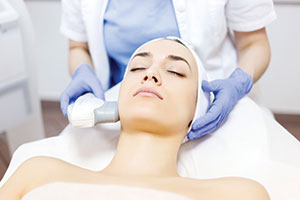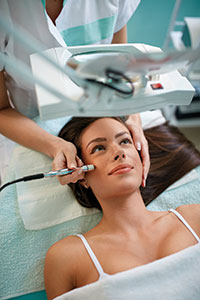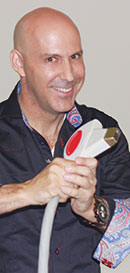When it comes to exfoliation, the skin care industry is rich with options, each providing a variety of results. Understanding the differences between various modalities can not only aid professionals in equipping their spas with the right tools, it can also help in knowing which method to choose based on each client’s desired results and expectations for downtime and cost.
Most are probably familiar with the saying, “Out with the old, in with the new.” While the concept can be applied to many things, it speaks directly to the process of exfoliation, which refers to any means of removing dead skin from the surface, thereby encouraging new skin growth.
And, while exfoliation is all about new skin, there is nothing new about exfoliation. Humans have been purposely sloughing, scrubbing, and shedding their epidermises throughout history: ancient Egyptians made scrubs with alabaster and sand; American Indians used dried corn cobs; and folks in the Middle Ages discovered old wine made an excellent peel. Today, “fish pedicures” have clients dipping their tootsies in water containing dozens of tiny Garra rufa fish that nibble away at callouses.
With such intriguing methods for sloughing off dead skin, exfoliation must be important. But, why is exfoliation so important? For starters, as individuals age, cell renewal naturally slows down, leaving the top layer of skin dead, dull, and thickened. Crystal Disheroon, certified laser technician, clinical laser educator, and licensed aesthetician, compares this process to the body’s metabolism, which also decreases as individuals age. If a person does the same exercises every day or eats the exact same diet, they will either gain weight or hit a plateau. How do they counteract plateaus? By continuously surprising their body with new exercises and alternating the foods they eat. In the same way, exfoliation surprises the skin; by removing old cells, new cells will continuously regenerate at a faster rate.
 Exfoliating also allows moisturizing, antiaging products to penetrate more deeply, rather than being absorbed by the dry top layer. For those with oilier, thicker skin or tendencies toward clogged pores, acneic skin conditions, folliculitis, pseudofolliculitis barbae, or keratosis pilaris, regular exfoliation reduces the possibility of bacteria pockets developing under dry skin and worsening these conditions.
Exfoliating also allows moisturizing, antiaging products to penetrate more deeply, rather than being absorbed by the dry top layer. For those with oilier, thicker skin or tendencies toward clogged pores, acneic skin conditions, folliculitis, pseudofolliculitis barbae, or keratosis pilaris, regular exfoliation reduces the possibility of bacteria pockets developing under dry skin and worsening these conditions.
If these reasons to exfoliate are not enough, how about the skin’s physical appearance? As one might suspect, dead skin does not reflect light, which makes it appear less luminous – and lower luminosity means less youthful-looking skin. Additional benefits include improved texture, a softer feel to skin, and minimized fine lines and pores.
This leads to the million-dollar question: what type of exfoliation is best for the skin?
Are there concerns for sensitive skin types? How often should one exfoliate? And what about pre- and post-exfoliation recommendations?
It is time to shed light on shedding skin.
AN OVERVIEW OF EXFOLIATION MODALITIES
There are three basic types of exfoliation: physical/manual, chemical, and mechanical/equipment.
Physical
Physical/manual exfoliation refers to any means of removing dead skin with the use of an abrasive brush, implement, or product. Exfoliation is performed either wet or dry by massaging, brushing, scraping, or filing the skin. Tools include dry skin brushes for the face and body, loofah sponges, washcloths, cleansing cloths, surgical scalpels (dermaplaning), and stainless-steel tools with a crushed diamond head piece (dermafiling). (Note: Some would include microdermabrasion in this category, although others would place it more in the mechanical/equipment category).
Many of these modalities may be performed at home but to avoid any risk of infection, dermaplaning and dermafiling should be performed only by a skin care professional. Dermaplaning removes dead skin cells and also vellus hair and pore congestion, such as black heads. Dermafiling provides similar results but skin is filed, rather than scraped, with a blade.
There are many products that physically remove dead skin – typically scrubs and cleansers with added exfoliating particles, including beads, ground pumice, rice particles, nut shells, diamonds, crystals, and diatomaceous earth (which is almost entirely made of silica). Some products are more aggressive than others and, while it might feel good or at least productive to use a harsher version, it is important not to tear the skin or cause abrasions. In particular, ground up walnut shells and apricot kernels are quite rough and jagged and should be used with care.
Beads made of plastic, known as microbeads, are rounder and smoother than shells but no longer available because they are derived from polyethylene and, therefore, not biodegradable. Eco-friendly alternatives are often made from bamboo and jojoba beads, both of which are gentle enough for regular use and do a nice job of exfoliating without harming the skin.
Chemical
Chemical exfoliation includes chemical and enzyme peels. The main difference between chemical and physical/manual exfoliation is that chemical peels are applied topically and the ingredients do all the work by penetrating into the skin’s glue layer.
Chemical peels include: alpha hydroxy acids, including lactic, malic, tartaric, citric, and mandelic; beta hydroxy acids, the most common of which is salicylic acid; trichloroacetic acid (TCA); and phenol. Many enzyme peels are naturally derived from active ingredients in fruits, including papaya, pineapple, and pumpkin.
Most peels either go through or around skin cells and destroy them. Alpha hydroxy acids disrupt the ionic bonding of corneocyte cohesion by dissolving the lipid bonds between the cells at the lower levels of the stratum corneum, causing the cells to unglue and shed. Beta hydroxy acids dissolve the glue that holds corneoctyes or dead skin cells in the top layers, allowing fresh cells beneath to emerge.
Mechanical
Mechanical/equipment exfoliation simply utilizes machines or specialized equipment to remove dead skin. Equipment ranges from devices suitable for homecare – such as electronic cleansing brushes – to equipment found in medical spas, like direct and indirect high frequency, microdermabrasion, and laser/IPL devices.
EQUIPMENT EXFOLIATION 101
Electronic cleansing brushes have come a long way since they first became popular in the at-home market about 14 years ago. They now come with regular or sensitive brushes and some are tapered to reach the nooks and crannies around the nose, mouth, and eyes. They also come with a wide range of price tags. While many people swear by their electronic cleansing brushes for both deep cleansing and exfoliation, most experts agree – clients should not overdo it. Once every day (or every other day, depending on the skin) is sufficient, and the brush should not be combined with harsh or exfoliating cleansers.
There are two methods of high frequency: direct and indirect. Direct high frequency increases circulation, helps reduce bacteria on the skin, and aids in exfoliation. Indirect high frequency involves the use of a current and may be combined with oils that aid in exfoliation.
Microdermabrasion has been popular for a number of years. It continues to be an in-demand treatment and with good reason. It is suitable for all skin types, has no down time, and can be used with antiaging serums and many other treatments, including chemical peels, for enhanced results. The hand piece is used to lightly spray medical-grade crystals across the skin, which sloughs off dead cells, and a suction attachment vacuums them up and away. There has been some question as to whether the tiny crystals can get embedded in the skin; for that reason, there are also crystal-free hand pieces which use a diamond-tipped head.
At the medical spa level, there are several options, including: laser resurfacing treatments that apply a 2940 erbium ablative laser beam over the treatment area, removing a fine layer of skin and helping create a skin renewal process; medical-grade hydradermabrasion that cleanses, exfoliates, and infuses skin, utilizing high pressure water infused with active serums and a vacuum to remove surface cells (clients often see immediate benefits of increased hydration, clarity, and tone0; and a combination of LED and ultrasound – first, a hand piece that feels like rough paper exfoliates, then, it creates CO2 bubbles to bring oxygen to the tissue. These treatments may be performed on the face or body.
 Advantages of Equipment Exfoliation
Advantages of Equipment Exfoliation
One of the biggest advantages of equipment exfoliation is what is known as long-term collagen remodeling. While this can be achieved in moderation with less aggressive treatments, in general terms, the more aggressive the treatment, the more dramatic the result.
Equipment exfoliation can also be more precise and targeted and any time it is combined with a heating element, it will result in skin that is tightened, giving it that toned, more youthful appearance.
According to Michelle Williams, certified laser instructor and clinical laser educator, a client’s decision to choose equipment exfoliation over other types should factor in not only the results he or she wishes to achieve but also skin type, lifestyle, and budgetary considerations. “Clients love the faster, more dramatic results that typically come with equipment exfoliation but, because these treatments go a bit deeper, there’s often more downtime associated with them. If someone cannot take off a few days from work to heal, then it might not be the right choice. Also, because they’re results oriented, they tend to be more expensive,” she says.
WHO IS A GOOD CANDIDATE?
Without a doubt, skin type plays a key role in determining whether a client is a good candidate for equipment exfoliation. Those with Fitzpatrick skin types I through IV typically do well with it, while those with skin types V through VI have to be a bit more careful to avoid potential hyperpigmentation. “We also have to look at what subcategories a client might walk in with,” says Disheroon. “For example, a client might be a II on the Fitzpatrick [scale] but also have melasma or sensitive skin.” Men who shave every day are often good candidates for equipment exfoliation because their skin is not only thicker but already accustomed to the daily shedding process.
However, those with sensitivity, rosacea, and acne may do best with chemical peels because physical and equipment exfoliation can aggravate their conditions. “Each layer of skin communicates with the layer adjacent to it; when you remove the top layer, it tells lower layers to make new cells. So, if a client has, say, acneic or bacteria-prone skin, it will produce more of the same,” says Disheroon.
The 2940 laser treatment can also be used to treat crepiness on the neck and chest, providing collagen production up to 12 months.
If a client is simply wanting smoother skin, he or she might do well with a series of chemical peels or a mild laser peel to get a rosy glow. But, if there are deep acne scars, surgical scars, or stretch marks involved, then, more aggressive treatments will be required. “This is why it’s so important [for clients] to consult with a skin care professional before any type of treatment – someone who really understands the skin and will take into account other factors,” Williams say. “If a client has sensitive skin, budgetary, or downtime restrictions, we can stretch out a series of less expensive treatments over time so that results are cumulative. We can get close to the results that more aggressive equipment offers; it will just take more time and patience.”
PRE- AND POST-CARE FOR EQUIPMENT EXFOLIATION
When using exfoliation equipment, sun exposure should be avoided for a minimum of two weeks prior to treatment. Retinoids, whether prescription or over-the-counter, should also be avoided anywhere from two days up to two weeks, depending on the strength.
With more aggressive treatments like the 2940 erbium ablative laser, a numbing cream is typically applied 30 minutes prior and downtime lasts five to seven days. Skin will be slightly blistered and swollen, similar to a bad sunburn, and a moisture barrier ointment should be applied for three to five days until skin heals.
Following treatment, skin should be cleansed with a mild, non-oily cleanser. A vinegar and distilled water rinse may also be applied, beginning on the day after treatment, three times a day for three days, to normalize the skin’s pH balance, minimize inflammation and risk of infection, and encourage the healing response.
More aggressive treatments can cause skin to purge impurities, so clients who tend to break out following treatment can also apply an antibacterial, antimicrobial gel to prevent this. Lotions with copper peptides, cooling agents, and mild enzymes can also be applied with care to help reduce inflammation, discomfort, or scar tissue formation.
Once skin is no longer red or irritated, foundation makeup can be used and an SPF of 30 or higher is a must, as skin will be especially sensitive to sun exposure. Tinted sunscreens are ideal post-treatment because they tend to be gentler and easier to wash off.
Exercise should also be avoided until skin is no longer red or swollen.
COMBINING EQUIPMENT EXFOLIATION WITH OTHER PROCEDURES
Some equipment procedures, such as IPL photo facial, do provide mild exfoliation because they produce heat, but they do not really remove much of the stratum corneum. However, applying a salicylic acid directly after a photo facial treatment can help penetrate products more deeply into the skin.
Photo facial can also be performed before 2940 erbium ablative laser peels and before fractional laser treatments.
Very oily, photo-aged, and leathered skin may benefit, first, from either a microdermabrasion treatment or dermaplaning to remove the top layer and bring oxygen to the skin via circulation, followed by a simple facial and glycolic or TCA peel. For the same type of skin but with added laxity, a 2940 erbium ablative laser peel yields excellent results.
EXFOLIATION FREQUENCY
Disheroon and Williams agree that mild exfoliation (brushes, gentle scrubs, products containing mild acid, retinoids, and so forth) should be part of a regular routine to keep skin looking polished. Clients with oily, thick, or photo-aged skin can typically exfoliate every day. Clients with normal or combination skin can exfoliate as often as every day or every other day. For sensitive skin types, exfoliation might be every two or three days. “If a client incorporates exfoliation into her or his regular routine, they can help prevent or at least slow down dead skin buildup,” Williams says. If skin experiences increased oil production, acne, dryness, sensitivity, or so forth, clients should simply back off on exfoliation for a day or so.
Major exfoliation (like equipment exfoliation) can be performed once every few months to keep a rosy flow and sun damage at bay. “Once you get your skin in the condition that you want,” Williams says, “then it’s just about maintenance. Most clients come in once every few months for milder forms of exfoliation and once a year, or even every other year, for more aggressive options.”
Regardless of skin type, many clients believe they get the best results from exfoliation by switching back and forth between physical, chemical, and mechanical modalities. As Disheroon reminds about keeping physically fit, “Doing the same exercises all the time yields the same results. The same is true with our skin. By continuously trying new types of exfoliation, we get different and better results, and many of these results are cumulative.”
Working with clients to determine the best types of exfoliation for their skin types, lifestyles, budgets, and skin care goals is an important step in helping them put their best face (or, in this case, skin) forward.
 Louis “The Laser Guy” Silberman is CEO of National Laser Institute, a national cosmetic laser and medical aesthetic training center founded a decade ago, and owns medical spas in Scottsdale, Arizona and Dallas, Texas. He is the author of “Make It Happen Online” and is a motivational marketing speaker. Silberman created the sixth most visited health and beauty website and was a semi-finalist for the Ernst & Young Entrepreneur of the Year Award in 2014.
Louis “The Laser Guy” Silberman is CEO of National Laser Institute, a national cosmetic laser and medical aesthetic training center founded a decade ago, and owns medical spas in Scottsdale, Arizona and Dallas, Texas. He is the author of “Make It Happen Online” and is a motivational marketing speaker. Silberman created the sixth most visited health and beauty website and was a semi-finalist for the Ernst & Young Entrepreneur of the Year Award in 2014.
This email address is being protected from spambots. You need JavaScript enabled to view it.